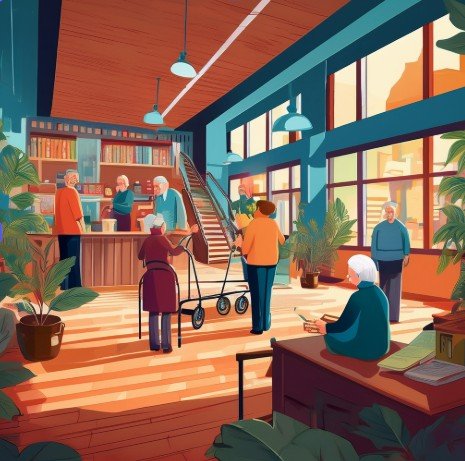AI & The Future of Work, Part 2
Friday, 31 October 2025By Patricia Lustig & Gill Ringland
This is the second Part of four connected blogs on AI and the future. Part 1 focused on what AI is good for and identified some issues. This section focuses on the context of work in 2040. Part 3 will focus on the future of work itself and finally Part 4 uses two different professions (IT and Healthcare) to illustrate how AI affects each profession differently.
We describe the context for work in 2040 from three aspects: the geopolitical, the organisational, and the social or personal. The following descriptions draw on research we (the authors) undertook for The Possibility Wheel. As futurists, we develop a range of potential, plausible futures. What follows is one plausible scenario – not a prediction, but a backdrop to explore work in 2040.
Our baseline assumption: AI itself is neutral. Its impact depends on how it is used.
The Geopolitical Context To 2040

By 2040, economic and demographic gravity has shifted eastward. Growth in China, India, and Southeast Asia, combined with a rising share of the working-age population in Africa and South Asia, has transformed global power dynamics.
The post-Cold War “international order,” once dominated by the West, has given way to a more multipolar, transactional, and fragmented world. Alliances are increasingly temporary and issue-based, shaped by national and local interests rather than broad ideological blocs.
Competing political and value systems coexist uneasily. The global majority is assertively non-aligned, challenging Western dominance without neatly falling into either authoritarian or democratic camps. Whilst a rules-based international order retains appeal, it no longer commands universal legitimacy. The international landscape is characterised by shifting issue-based alliances driven by national and local interests.
At the same time, existential global challenges continue to mount: global heating, conflict and insecurity, water and resource scarcity, pandemics, and the misuse of technology and AI.
The global economic system is still seen by many to be unjust, inefficient and wasteful. Progress toward the UN Sustainable Development Goals has stalled or reversed in the wake of overlapping crises.
Existing political structures have struggled to respond to increasingly interconnected, transnational problems - such as global heating, breakdown in international relations and pandemics . In our book, The Possibility Wheel we explore the underlying structural problems impeding the tackling of these threats – and it is hopeful to see that some new structures have emerged.
The Organisational Context To 2040
Technology

By 2040, there will be new technology capabilities with ongoing development in GenAI and AI Agents. Adoption of technology will be uneven, depending on location, culture, application and society.
AI technology development is dominated by the vested interests of a few major corporations and state-backed players. AI’s capability has improved and new applications continue to be developed and their appropriate roles are better understood. Routine administrative and research tasks are largely automated. AI augmentation takes advantage of the differing strengths of AI and human capabilities.
Electricity generated by renewables has become the cheapest form of energy, though adoption varies by region. With the U.S. lagging since its 2025 policy retreat, China has become the largest beneficiary of the global energy transition. The growth of electric vehicles and the Internet of Things has driven electricity demand higher, straining already fragile grids.
A major focus of technology to 2040 has been to tackle systemic global challenges. Health sciences have been revolutionised by personalised medicine and new vaccines. Agriculture has been revolutionised by drought and pest resistant crops, new animal vaccines and automation of agriculture.
These gains are constrained by resource bottlenecks — critical minerals, clean water, and arable land — all increasingly controlled by large multinationals. The result is a more unequal and unstable world economy.
Employment

By 2040 gig work has grown and is almost universal. Some sectors — such as healthcare, education, and government — still provide some traditional employment, with long-term contracts. Many multinationals operate with small permanent central staff and large ecosystems of contract or gig workers, connected through proprietary corporate platforms, which function as de facto labour markets. Stability and benefits are rare; workers have precarious employment and income.
Most knowledge work is hybrid (Working from home and in the office) or location-agnostic. Physical work sees major changes as robot technology improves and is able to handle a wider range of tasks in automation and augmentation modes.
Employability often requires continuous updating of skills and credentials. Lifelong learning and continuing education are often delivered by AI-driven learning systems.
The Social & Personal Context To 2040
Population And Family

Fertility rates continue to decline, with many countries well below replacement levels. Shrinking working-age populations support growing elderly cohorts. Families are smaller, and one-person households are more common, reshaping housing markets and social support systems. With fewer large families to rely on, alternative networks of care emerge — from friendship-based communities to civic organisations.
The way societies deliver essential services varies by region. In many parts of the world, extended families and kinship networks remain the backbone of care and support. In aging societies, where family size has shrunk, civic organisations and local governments play a stronger role. Guild-like associations and community cooperatives are re-emerging, providing social support, skills exchange, and care. Retirees form a crucial volunteer base, expanding the role of older generations in civic life.
Migration And Urbanisation
Climate change, conflict, and inequality drive greater migration, particularly from the Majority World to Mature Economies. Countries that integrate newcomers effectively reap demographic and economic advantages, while those that resist face greater inequality, instability, and political polarisation.
Rural-to-urban migration continues, as urban areas are seen to offer better employment, education, and healthcare.
Media And Social life

By 2040, the social media platforms of today are relics. The platforms that dominated the early 2000s lost relevance as users demanded privacy, authenticity and face to face interaction. Localised, smaller-scale digital networks now coexist with a resurgence of in-person communities. Traditional media has largely disappeared, while new digital ecosystems raise fresh challenges in trust, identity, and civic discourse.
Some societies embrace community-based platforms designed to build civic trust and knowledge exchange, while others drift toward immersive, isolating media ecosystems. The global picture reflects diverse local choices and cultural values.
Implications
In Part 3 we explore what this image of 2040 means for the future of work and the role of AI. We discuss how it might play out for different kinds of work in different sectors. The difference between how AI affects the same type of job in different sectors will surprise you.